
Opole Voivodeship, is the smallest and least populated voivodeship (province) of Poland. The province's name derives from that of the region's capital and largest city, Opole. It is part of Silesia. A relatively large German minority lives in the voivodeship, and the German language is co-official in 28 communes.
Edmund Kalikst Eugeniusz Charaszkiewicz was a Polish military intelligence officer who specialized in clandestine warfare. Between the World Wars, he helped establish Poland's interbellum borders in conflicts over territory with Poland's neighbours.

Janusz Meissner was a Polish writer and journalist, and a pilot of Polish Air Force.
This is a list of German language place names (toponyms) for the region of Upper Silesia. Upper Silesia today is in the Opole Voivodeship and the Silesian Voivodeship in Poland.
Gmina Głogówek, German Gemeinde Oberglogau is an urban-rural gmina in Prudnik County, Opole Voivodeship, in south-western Poland, on the Czech border in Upper Silesia. Its seat is the town of Głogówek (Oberglogau), which lies approximately 21 kilometres (13 mi) east of Prudnik and 37 km (23 mi) south of the regional capital Opole.
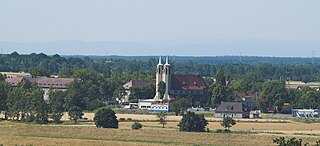
Szczepanowice is a district of Opole, Poland.

Tadeusz Puszczyński was a Polish military intelligence officer who commanded the Polish General Staff's Destruction Group during the Third Silesian Uprising.
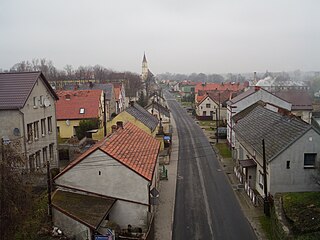
Racławice Śląskie, formerly named Racławice Niemieckie is a village located in the Opole Voivodeship, near the border with the Czech Republic. It belongs to the Prudnik County. Most inhabitants are descendants of Poles expelled after 1945 from the area of Berezhany Raion, who replaced the expelled Germans. Until recently, Racławice was a rail junction, with trains leaving in three directions - towards Nysa, Kędzierzyn-Koźle and Głubczyce. Currently, the line Racławice-Głubczyce is closed. It lies approximately 8 kilometres (5 mi) south-west of Głogówek, 14 km (9 mi) east of Prudnik, and 42 km (26 mi) south of the regional capital Opole. Historically located in Upper Silesia, in the Prudnik Land.
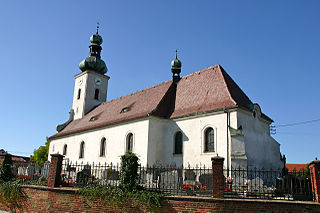
Biedrzychowice, German Friedersdorf, is a village in the administrative district of Gmina Głogówek (Oberglogau), within Prudnik County, Opole Voivodeship, in south-western Poland, close to the Czech border. It lies approximately 6 kilometres (4 mi) east of Głogówek (Oberglogau), 26 km (16 mi) east of Prudnik, and 37 km (23 mi) south of the regional capital Opole. Historically located in Upper Silesia, in the Prudnik Land.

Błażejowice Dolne is a village in the administrative district of Gmina Głogówek, within Prudnik County, Opole Voivodeship, in south-western Poland, close to the Czech border. It lies approximately 5 kilometres (3 mi) north-west of Głogówek (Oberglogau), 19 km (12 mi) east of Prudnik, and 34 km (21 mi) south of the regional capital Opole. Historically located in Upper Silesia, in the Prudnik Land.
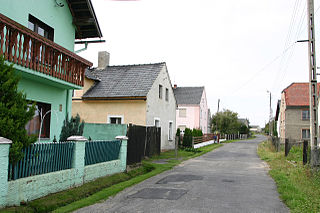
But, German Neuvorwerk is a village in the administrative district of Gmina Głogówek, within Prudnik County, Opole Voivodeship, in south-western Poland, close to the Czech border. It lies approximately 8 kilometres (5 mi) north-west of Głogówek (Oberglogau), 20 km (12 mi) north-east of Prudnik, and 30 km (19 mi) south of the regional capital Opole. Historically located in Upper Silesia, in the Prudnik Land.

Dzierżysławice, is a village in the administrative district of Gmina Głogówek, within Prudnik County, Opole Voivodeship, in south-western Poland, close to the Czech border. It lies approximately 3 kilometres (2 mi) west of Głogówek (Oberglogau), 18 km (11 mi) east of Prudnik, and 38 km (24 mi) south of the regional capital Opole. Historically located in Upper Silesia, in the Prudnik Land.

Golczowice, German Golschowitz is a village in the administrative district of Gmina Głogówek, within Prudnik County, Opole Voivodeship, in south-western Poland, close to the Czech border. It lies approximately 8 kilometres (5 mi) north-west of Głogówek (Oberglogau), 18 km (11 mi) north-east of Prudnik, and 32 km (20 mi) south of the regional capital Opole. Historically located in Upper Silesia, in the Prudnik Land.
Nowe Kotkowice, German Neu Kuttendorf is a village in the administrative district of Gmina Głogówek, within Prudnik County, Opole Voivodeship, in south-western Poland, close to the Czech border. It lies approximately 5 kilometres (3 mi) north-east of Głogówek (Oberglogau), 25 km (16 mi) east of Prudnik, and 33 km (21 mi) south of the regional capital Opole. Historically located in Upper Silesia, in the Prudnik Land.

Stare Kotkowice, German Alt Kuttendorf is a village in the administrative district of Gmina Głogówek, within Prudnik County, Opole Voivodeship, in south-western Poland, close to the Czech border. It lies approximately 3 kilometres (2 mi) east of Głogówek (Oberglogau), 24 km (15 mi) east of Prudnik, and 37 km (23 mi) south of the regional capital Opole. Historically located in Upper Silesia, in the Prudnik Land.

Sysłów, German Syßlau is a village in the administrative district of Gmina Głogówek, within Prudnik County, Opole Voivodeship, in south-western Poland, close to the Czech border. It lies approximately 9 kilometres (6 mi) north-west of Głogówek (Oberglogau), 19 km (12 mi) north-east of Prudnik, and 31 km (19 mi) south of the regional capital Opole. Historically located in Upper Silesia, in the Prudnik Land.

Wierzch is a village in the administrative district of Gmina Głogówek, within Prudnik County, Opole Voivodeship, in south-western Poland, close to the Czech border. It lies approximately 7 kilometres (4 mi) west of Głogówek (Oberglogau), 15 km (9 mi) east of Prudnik, and 37 km (23 mi) south of the regional capital Opole. Historically located in Upper Silesia, in the Prudnik Land.
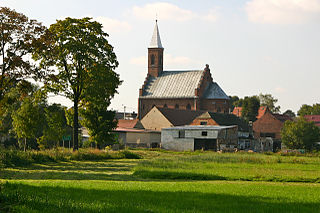
Wróblin is a village in the administrative district of Gmina Głogówek (Oberglogau), within Prudnik County, Opole Voivodeship, in south-western Poland, close to the Czech border. It lies approximately 6 kilometres (4 mi) south-east of Głogówek (Oberglogau), 26 km (16 mi) east of Prudnik, and 40 km (25 mi) south of the regional capital Opole. Historically located in Upper Silesia, in the Prudnik Land.
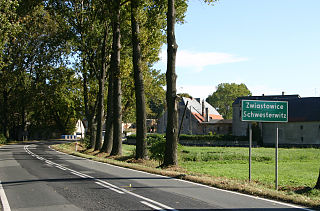
Zwiastowice, German Schwesterwitz, is a village in the administrative district of Gmina Głogówek, within Prudnik County, Opole Voivodeship, in south-western Poland, close to the Czech border. It lies approximately 8 kilometres (5 mi) east of Głogówek, 28 km (17 mi) east of Prudnik, and 37 km (23 mi) south of the regional capital Opole. Historically located in Upper Silesia, in the Prudnik Land.
The Duchy of Prudnik was one of the numerous duchies of Silesia ruled by the Silesian branch of the royal Polish Piast dynasty. Its capital was Prudnik in Upper Silesia.















